One of the (many) really wonderful things about traveling for an extended period of time is the freedom you have in your decision-making process. I think this is one of the main differences between vacationing vs. traveling…on a vacation, you have a limited period of time and it usually benefits you to make plans as to what places, sites, and cities you are going to visit in order to fit it all in. On the other hand, traveling provides you with the luxury of listening to your gut. Don’t like a place? Leave. Really like a place? Stay a day or two longer until you feel restless again.
It was this very gut feeling that told us to cross over from Cambodia into Vietnam via a boat down the Mekong. We hadn’t really met any other travelers in Cambodia that had done this, but the travel books made it sound cool so we decided to go for it. Our final destination was Can Tho, a smallish town situated along the Mekong and famous for its floating markets. This would prove to be somewhat more involved travel day, as there weren’t really direct boats from Phnom Penh to Can Tho. Rather, we took a van to a slow boat, which stopped at the Cambodia/Vietnam border so we could process our passports, then hopped on a fast boat to Chau Doc, on the Vietnam side. While we were zooming down the Mekong, one of the guys on the boat asked us if we wanted to take a van from Chau Doc over to Can Tho for US$8. We were a bit worried that he was overcharging us since you usually pay a premium for convenience like this in SE Asia. So we told him we would find our own way to the bus station and figure it out. When we landed at Chau Doc, we climbed out of the boat, put our packs on and asked for directions to the bus station. Surprise, Hope and Jeremy! The bus station is on the other side of the river. I have no idea if there is any logic behind dropping you off on the wrong side of the river other than to make you more likely to buy a ticket from this guy’s company. Without any other real choices (other than swimming), we hopped back on a longtail boat across the river, where we were loaded onto some two-wheeled bicycle-drawn carts (known as xe loi and apparently unique to the Mekong Delta), and ended up at the bus station, where we boarded another van towards Can Tho. For the record, that’s: 3 boats, 2 vans, and a xe loi to get from Cambodia over to Vietnam. Here’s Jeremy in his xe loi:
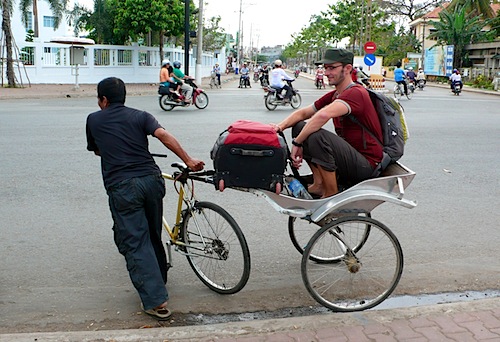
I am not sure why, but for some reason we keep irrationally expecting the countries in SE Asia to be more similar to each other than they actually are. Perhaps it is because we’ve met a lot of people who have traveled the entire region (as we are doing now) and so we tend to lump all the countries together under the term “Southeast Asia.” The countries are, in fact, completely different, despite the fact that the terrain often looks the same. Here we are, floating along the Mekong, and boom—as soon as you cross the border into Vietnam, suddenly all the houses are on stilts and the people are wearing “rice picker” hats. By the way, I totally thought this was a Vietnamese stereotype, but the people here really do wear these hats! And it’s not just one person here and there, but almost every woman (men do not seem to wear them) in the countryside seems to be wearing these cone-shaped toppers. Interestingly, women also wear these brightly colored and patterned pajama-esque Lycra pantsuits.
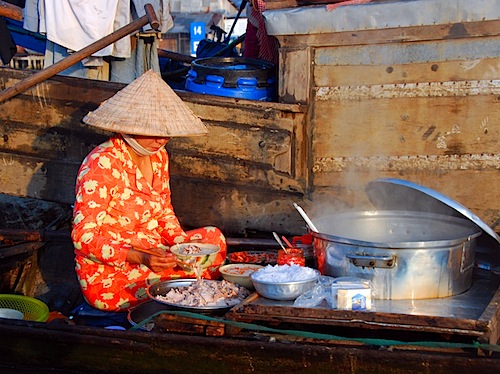
Jook vendor at the Cai Rang floating market near Can Tho.
The main reason why people visit Can Tho is to visit the floating markets nearby in the Mekong. We met a super cute Dutch couple (Joachim and Rianne) on the trip over from Cambodia, and we decided to look for a floating market tour together. You can book these tours through the Can Tho Tourist office but you will end up on a large boat that is not able to navigate the small canals that wind their way through the countryside and drain into the Mekong. Plus, if you book a tour directly with one of the locals, the money goes directly towards feeding their family.
In order to book a tour, you simply stand around on the main road where the boats dock and within minutes, a local Vietnamese lady will inevitably approach you about a day tour. That’s how we met Phuong, an incredible Vietnamese lady with the most amazing laugh. We tried to negotiate with her for the price of our boat tour, but she wouldn’t budge from US$50 for all 4 of us. But we thought she was so sweet and cute we just let it slide. What’s a few bucks when you really enjoy the company?
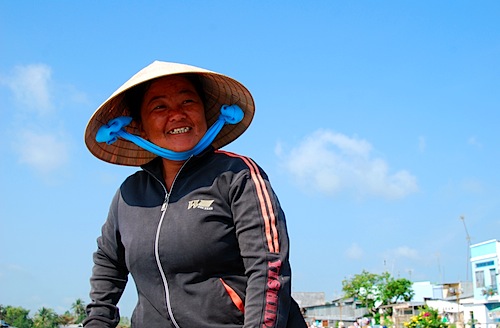
Phreaking phenomenal Phuong.
Because the floating markets are busiest early in the morning, Phuong picked us up at the ungodly hour of 5:30AM. We got to see the sunrise over the Mekong, which was not a bad way to spend our first morning in Vietnam.
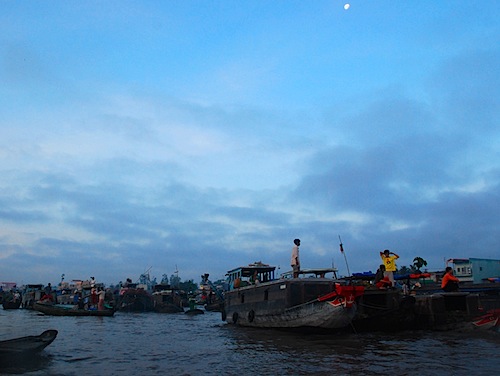
Our plan was to visit two different floating markets: Cai Rang, which is a larger market but more heavily touristed, and Phong Dien, which is famous because the people who vend and shop there do not use motors, but paddle their boats instead. Most of the people who take part in these markets are not buying for themselves, but for vegetable markets and restaurants, i.e., they are buying in bulk. Still, I wonder if they think it is strange that a bunch of tourists pay money to see them do their grocery shopping?
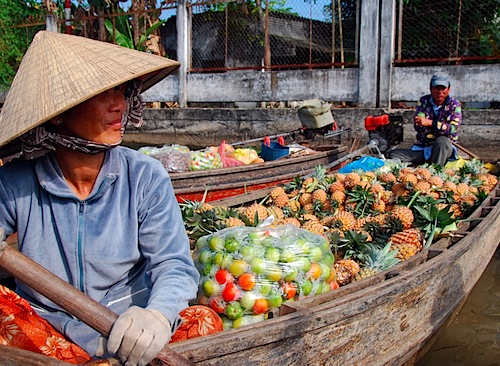
Pineapple vendor at the Phong Dien floating market.
So that buyers can easily tell what a boat is selling, vendors hang their wares on a long pole sticking straight up out of the boat. This guy was like the Costco of Cai Rang!:
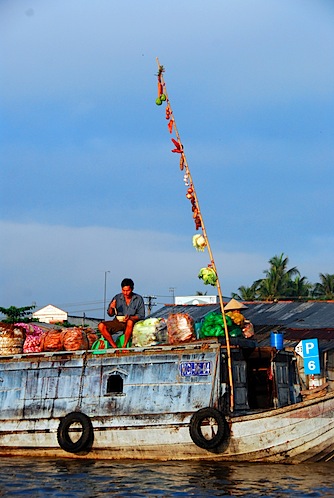
Also cool to note: the boats on the Mekong are painted with circular eyes (we would find out later that boats along the Red River up north are painted with slanted eyes). Does anyone know why this is the case?
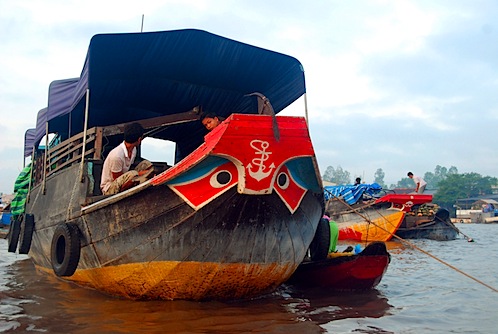
To be quite honest, we were a little disappointed with the actual markets…I guess we thought they would be bigger. In fact, they are quite small, in particular Phong Dien, which was basically a collection of about 20 boats bumping into each other as people did business. But it really didn’t matter, we had so much fun on the boat with Joachim, Rianne and Phuong that the actual sights seemed almost inconsequential. We basically meandered around the Mekong, chatting and laughing and getting to know each other. by the way, Phuong also brought her teenage son on the boat, but he didn’t talk much (I think he doesn’t speak English).
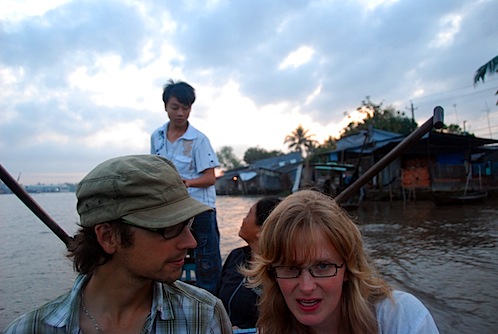
Joachim and Rianne, with Phuong’s son in the background.
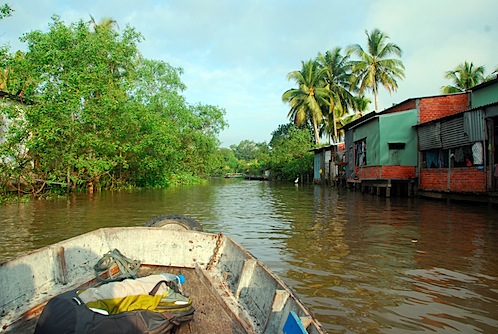
In addition to seeing the markets and the small canals, Phuong also brought us to a rice noodle “factory.” It was really interesting! Now we totally know how to make rice noodles.
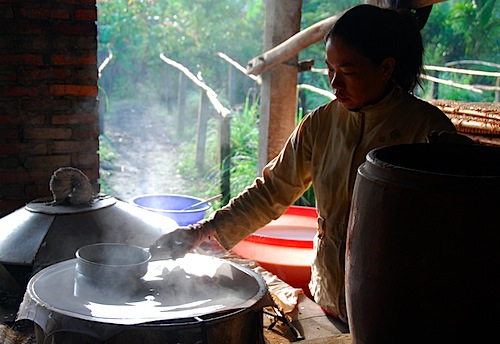
And, we got to see a bunch of the countryside, where Phuong picked a bunch of random fruits for us to taste, and we got to see those famous Vietnamese rice paddies.
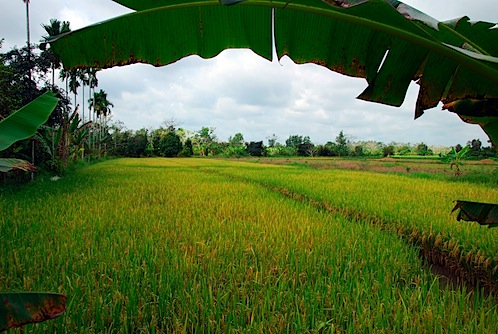
Phuong was really excited to show us something she called “the moneky bridge.” She took us to what was essentially a pole with a handrail stretched across the river and I started to walk across it when she literally yanked me back and told Jeremy to go first. I figured it was a precarious crossing so she wanted a guy to go first. As Jeremy was halfway over the bridge, she started giggling like crazy…”Look! Now there’s one monkey on the bridge!!!” She REALLY cracked herself up, and Jeremy was totally confused, like “am I supposed to cross this thing or not?” Which made the entire episode incredibly amusing to me. ![]()
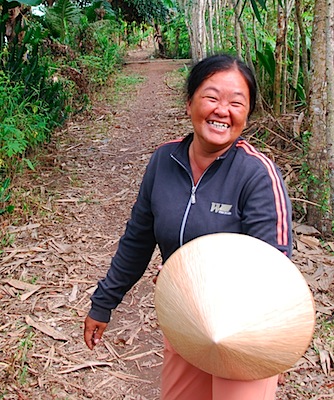
Phuong, unable to contain herself.
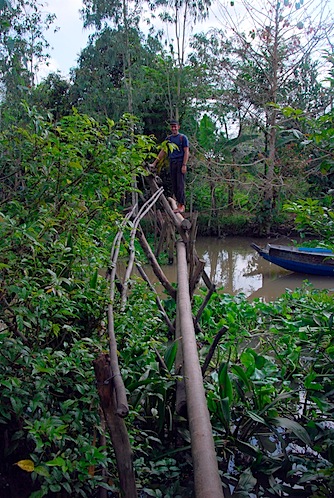
Jeremy, the monkey on the bridge.
We ended the tour by stopping for lunch at a nice place along the river, where Joachim and I played with snakes.
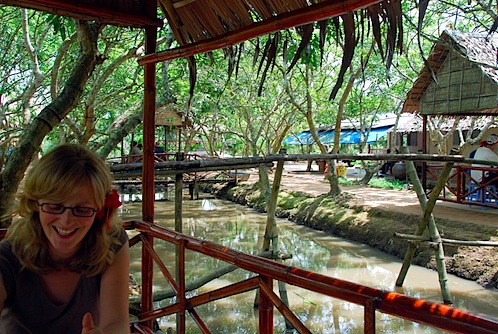
Rianne at our lunch spot along the Mekong.
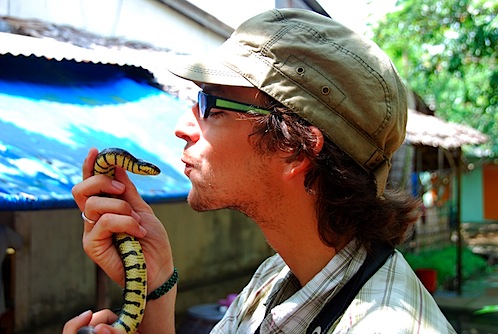
Joachim, getting fresh.
We had an awesome time in Can Tho! This was one case where the whole experience was definitely a lot greater than the sum of its tourist sites. Thanks to the cutest Dutch couple we’ve ever met (Joachim and Rianne, that’s you) and Phuong for making our stay in Can Tho so memorable. And thanks, gut feeling, for steering us right.
P.S. As a final shout-out to Phuong, this is the contact information listed on the card she gave us (I believe the phone number and email address are her brother’s): 0913 618 056, triet_quang@hotmail.com.